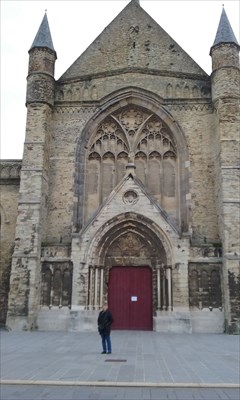[EN] The original church, built on the site of the present transept, dates from the beginning of the thirteenth century. This church was rectangular with 2 facade towers for entrance.
Very damaged during the war between France and England in 1346-47, the building was rebuilt and enlarged under the English occupation of the second half of the fourteenth century until the sixteenth century.
Our Lady is thus attached to the Archbishopric of Canterbury. In the second half of the 15th century, the church became the most important religious building in the city.
For the expansion works, the English call on their Flemish allies. They will build the upper parts of the nave, the choir and the brick tower of sand since stone quarries are inaccessible.
In 1558, Calais was reconquered by France, and Notre Dame became, after the destruction of the church of St. Nicholas which would become the citadel, the most important church in the city.
In the 17th century the chapel of axis called the chapel of the Virgin extends the edifice. The length of 88m allows to accommodate more faithful (6000).
At the time of the Revolution, the church was transformed into a temple dedicated to the worship of reason and a warehouse and then returned to worship in 1802.
At the end of the 19th century, in 1863, the dean of Calais, the archpriest of Lencquesaing engaged in decoration works in Gothic style with plastered ogives covering the wooden vaults, a plaster plaster covered the walls and the main portal was rebuilt Giving a style "Tudor" then in vogue at that time in Calais.
Bombed by the allies on 23 September 1944, the belfry collapsed on the northern transept.
Threatened initially of total destruction at the Liberation, it has been the subject of a vast restoration campaign since the 1960s.

[FR] L’église d’origine, construite à l’emplacement de l’actuel transept, date du début du XIIIe siècle. Cette église était de forme rectangulaire avec 2 tours de façade pour l'entrée.
Très endommagée pendant la guerre entre la France et l'Angleterre en 1346-47, le bâtiment est reconstruit et agrandi sous l’occupation anglaise de la deuxième moitié du XIVe siècle jusqu’au XVIe siècle.
Notre Dame est ainsi rattachée à l'archevêché de Canterbury. L'église deviendra ainsi dans la 2e moitié du XVe siècle l'édifice religieux le plus important de la ville.
Pour les travaux d'agrandissement, les anglais font appel à leurs alliés flamands. Ils vont construire les parties hautes de la nef, le chœur et le clocher en brique de sable étant donné que les carrières de pierre sont inaccessibles.
En 1558, Calais est reconquise par la France et Notre Dame devient ainsi, après la destruction de l'église Saint- Nicolas qui deviendra la citadelle, l'église la plus importante de la ville.
Au XVIIe siècle la chapelle d'axe dite la chapelle de la Vierge prolonge l'édifice. La longueur de 88m permet d'accueillir plus de fidèles (6000).
À la révolution, l'église est transformée en temple dédié au culte de la raison et en entrepôt pour être ensuite rendue au culte en 1802.
Fin XIXe siècle, en 1863, le doyen de Calais, l'archiprêtre de Lencquesaing engage des travaux de décoration de style gothique avec des ogives en plâtre qui recouvrent les voûtes en bois, un enduit en plâtre recouvre les murs et le portail principal est reconstruit donnant un style «Tudor» alors en vogue à cette époque à Calais.
Bombardée par les alliés le 23 septembre 1944, le clocher s’effondre sur le transept nord.
Menacée dans un premier temps de destruction totale à la Libération, elle fait l'objet d'une vaste campagne de restauration depuis les années 1960.
Sources : Notre-Dame